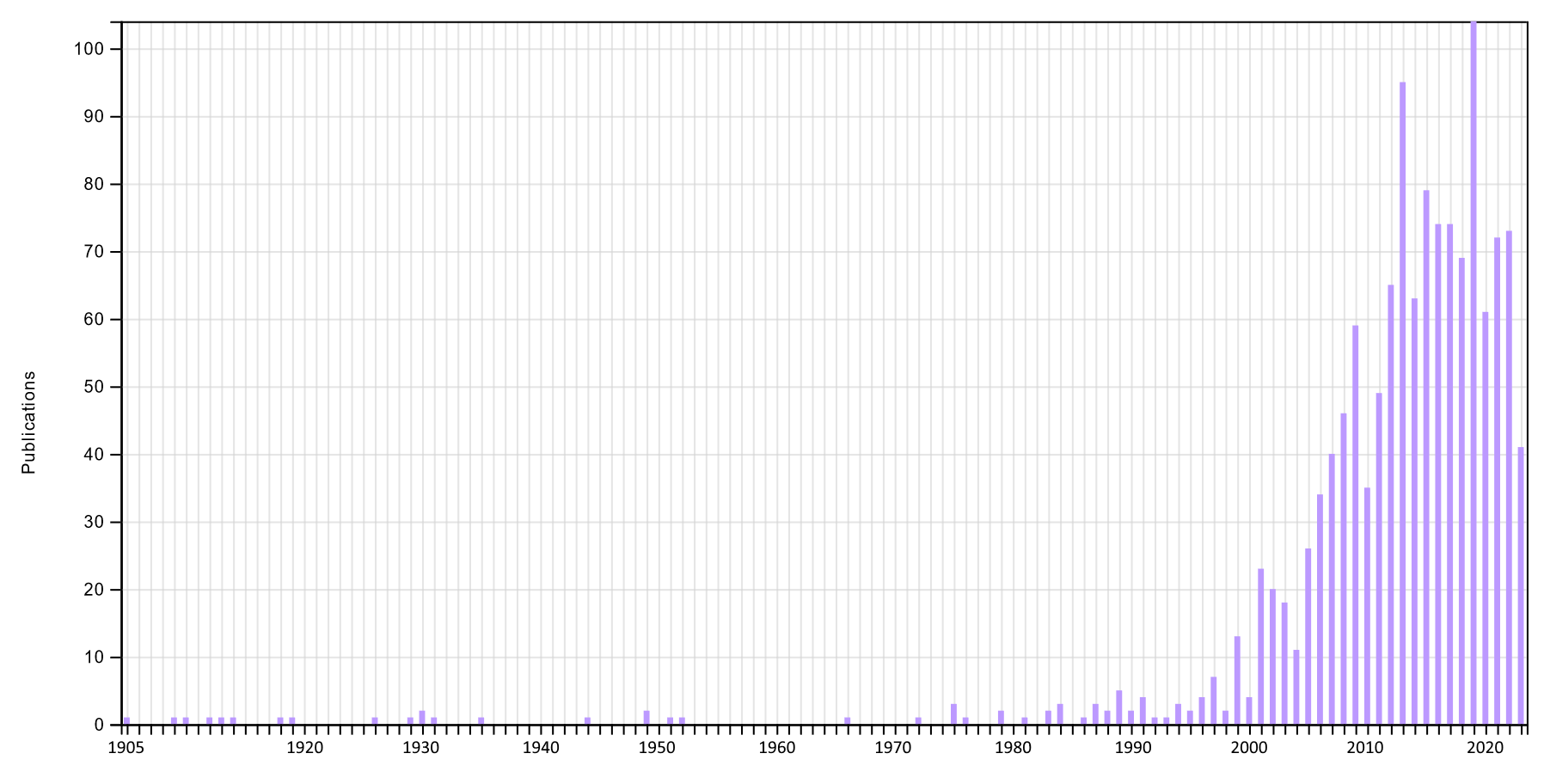
1. What is synesthesia?
2. How common is it, and what is the etiology?
3. What is the evidence that synesthesia is a bottom-up sensory phenomenon (and a top-down conceptual one)?
4. How can this evidence be reconciled?
5. Describe the theories of synesthesia that explain it in terms of cross-activation, disinhibited neural feedback, or reduced neural plasticity.
6. What are the implications of synesthesia for multisensory perception; the binding problem; and metaphor, creativity, and language?
- definition: a stimulus in one sensory modality evokes an additional experience in an _________ sensory modality (intermodal synesthesia) or in a different aspect of the same modality (intramodal synesthesia)
e.g., hearing a word spoken causes a particular flavour sensation
e.g., seeing an achromatic letter or number that also produces a colour experience
- etymology: “joined sensation,” from Greek syn = together + aisthesis = perception
- synesthesia links two normally independent ______: the subjective qualities of conscious experience (synesthesia has been called “qualia becoming deranged”)
- the stimulus that triggers the synesthesia is the inducer, and the modality in which the resulting synesthesia is experienced is the concurrent
- various types are identified using “inducer → concurrent”
e.g, grapheme → colour synesthesia
- there are over ___ different types of synesthesia, including grapheme → colour, tone → colour, and even (rarely) letter → gender
• Gustav Fechner (1871): surveyed coloured letter experience among 73 synesthetes
• Francis Galton (1880, 1881, 1883)
- described a synesthete who perceived dates as coloured
- claimed that the colours were derived from a _______ ____ used for childhood instruction
- also found that synesthesia ran in families
- suggested that both environmental and genetic components were responsible for synesthesia
• Mary Whiton Calkins (1894): first used the term “___________” in an English publication
• in the 20th century, psychology was dominated by the rise of behaviourism; thus, there was little interest in conscious phenomena--especially ones as bizarre and inexplicable as synesthesia
• due to the cognitive revolution, interest began to increase in the late 1970s and 1980s, and surged with the use of functional ____________ in the late 1990s and 2000s
• Baron-Cohen et al. (1987; 1996): Test of Genuineness (TOG)
- developed ____ for spoken word → colour synesthesia
- participants are given different spoken word inducers, and choose a colour square that most closely matches the concurrent
- retested after several weeks or months, and ___________ is determined:
synesthetes score 70-90%
controls score 20-38%
- Baron-Cohen & colleagues (2006): Revised Test of Genuineness (TOG-R) uses greater range of standardized colours (Pantone Matching System®)
• Cytowic (2004): diagnostic criteria
1. automatic and ___________: occurs without any conscious effort
2. _________ extended: some synesthetes experience the concurrent in the same physical location as the inducer; for others, it floats around them in space
3. consistent (over time), elementary (not pictorial, but generic in quality: e.g., not an entire visual scene, but just a colour or a shape), and ________ (e.g., not “green,” but “spring leaf green” or “lime pale green”)
4. highly _________: aids in remembering stimuli (e.g., grapheme → colour synesthesia helps spelling); synesthetes are more likely to have eidetic memory
5. loaded with ______: associations can be intensely aesthetically pleasing--or displeasing (e.g., “Derek” tastes of earwax)
• Eagleman et al. (2007):
- problem: some research groups simply use a self-report _____________ to determine if a person has synesthesia
- developed a single protocol for testing several types of synesthesia
- has a standardized scoring system
- The Synesthesia Battery is available online at www.synesthete.org
- 1 in 23 people has some type of synesthesia (Simner et al., 2006); equal in males and females (Simner & Carmichael, 2015)
- 1 in 90 has grapheme → colour synesthesia (Simner et al., 2005)
- most common types are grapheme → colour, and days of the week → colour synesthesia
- those who have one type of synesthesia are more likely to have another type as well (about 40-50% chance)
- synesthesia is 8 times more common in _______, poets, & novelists
e.g., famous artists with synesthesia: Vladimir Nabokov, David Hockney, and Wasily Kandinsky; also, Nobel Prize-winning physicist Richard Feynman
• __________: present from birth
- heritable: up to 40% of a synesthete’s first- and second-degree relatives also have it
- can skip generations
- family members with it do not necessarily have the same kind of synesthesia
- if family members do have the same kind of synesthesia, they do not necessarily have the same associations (e.g., mom sees 5 as green, daughter sees 5 as red)
• ____________: acquired after birth
- may result from stroke or closed-head trauma, temporal lobe epileptic seizures, or blindness, and can be permanent
- may be temporary (e.g., due to hallucinogenic drugs like LSD, meditation, or sensory deprivation)
_____________: if two synesthetes both have grapheme → colour synesthesia, they are not likely to have the same response
e.g., one synesthete may see the letter X as white, but another may experience it as red
Bottom-up processing (Ramachandran & Hubbard, 2001a):
Expt. 1:
- constructed displays of randomly placed graphemes (5s), but other graphemes (2s) were placed in the display, forming a certain shape (e.g., a triangle)
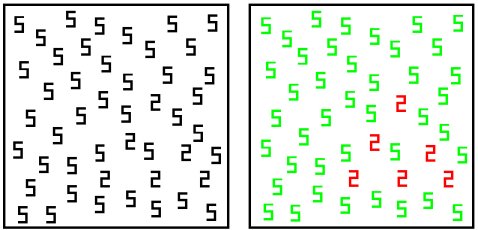
- difficult for non-synesthetes to detect the shape (~60% correct); for grapheme → colour synesthetes, the shape popped out (~90% correct)
- ___-___ is due to early visual processing
Expt. 2:
- graphemes were placed at point of fixation on a screen and gradually moved outwards to the periphery
- the size of the grapheme was scaled up to ensure it was still identifiable
- beyond 11° of eccentricity, the grapheme was clearly visible, but lost its ______

Expt. 3:
- individual graphemes presented in the periphery (< 11°) are easily identified
- however, when other letters flanked the target, it was difficult to identify
- these _______ graphemes still evoked the appropriate colour
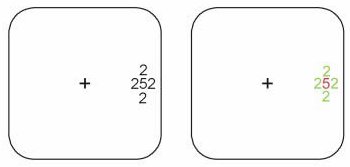
- this process must take place at an early _______ level, rather than a higher cognitive level
Conclusion: synesthesia is a _______ sensory phenomenon?
Perception vs. imagination (Nunn et al., 2002):
- spoken word → color synesthetes placed in PET scanner
- spoken words caused activation in V4 (but not other visual areas)
- non-synesthetes scanned while they imagined colour: no activity in V4
- synesthesia is like __________, not imagining
______________ (Mills et al., 1999):
- participants given Stroop task: coloured numbers briefly shown to grapheme → colour synesthete
- task: name each colour as quickly as possible
- conditions:
• matched condition: number (e.g., 2) presented in actual colour (e.g., blue) of inducer → concurrent relationship (i.e., 2 → blue)
• mismatched condition (e.g., 2 shown in red)
• control condition: all numbers presented in black ink
- results: mismatched condition produced significantly ______ performance (25 s) than matched condition (15 s)
_____________ (Johnson et al., 2007):
- grapheme → colour synesthetes reported experiencing a one-way relationship
e.g., seeing a number would result in a colour experience
e.g., seeing a colour would not cause a number to be seen
- on Stroop task, colour-naming identification was slower in the mismatched condition
- however, in the mismatched condition, digit-naming was also slower
- this implies that synesthesia can be _____________
i.e., graphemes → colours, and colours→ graphemes
Top-down processing: attention (Ramachandran, 2000):
- created large graphemes (e.g., a 5) out of different smaller graphemes (e.g., 2s), called “_____ figures” (Navon, 1977)
- when grapheme → colour synesthete attended to figure’s component graphemes (i.e., the 2s), it was seen in the colour evoked by 2 (e.g., red)
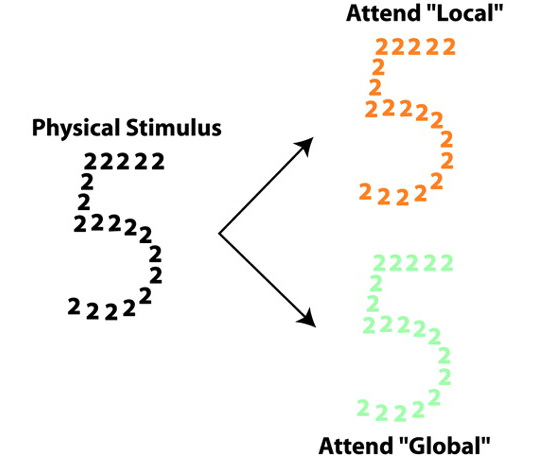
- when figure attended as a global form (i.e., a 5), it was seen in the colour evoked by 5 (e.g., green)
- _________ is important for binding colours to forms
Top-down processing: _______ (Dixon et al.., 2006):
- synesthete shown ambiguous character in two different contexts:
black digits: ![]()
black letters: ![]()
- the digit 5 and the letter S were exactly the same stimulus
digit 5 seen as pink
letter S seen as green
- top-down processing (i.e., _______ and meaning) affects synesthetic experience
Top-down processing: concepts (Dixon et al., 2000: “Five plus two equals ______”)
- tested grapheme → colour synesthete
- she saw 7 as yellow; identified 7 slower when it was printed in blue ink
- she was shown a series of slides, each containing one symbol
e.g., “5” then “+” then “2” then “=”
- final slide showed a colour patch
e.g., yellow or blue
- task: name colour as quickly as possible
- result: was over 250 ms slower in mismatch condition (blue patch) than in match (yellow)
- conclusion: synesthetic experience can be elicited by ________--not just by stimuli that are physically present
Ramachandran et al. (2003):
- proposed that number grapheme → colour synesthesia has two subtypes
- based on either perceptual or conceptual stimulus attributes:
• _____ synesthetes: processing is primarily bottom-up
- thus colours are elicited by the actual visual appearance of a grapheme
e.g., 7 → yellow
• ______ synesthetes: experience is affected by top-down processing
- thus colours are elicited by the concepts conveyed by the stimuli
e.g., Arabic numerals, Roman numerals, and days of the week, which all represent ordinality
Dixon et al. (2004):
- proposed two subtypes, based on experience in external or internal space:
• __________ strongly experience colours as overlays “projected” and bound to a grapheme, in the outside world
• ___________ experience weaker synesthetic colours “in the mind’s eye” only
- proposed that projectors = lower synesthetes, and associators = higher synesthetes; however, this is the subject of some dispute (see Ward et al., 2007)
• people are just _____
- but this is not an explanation
• learned associations (e.g., coloured alphabet blocks or refrigerator magnets), or memories
- but color-blind synesthete (S.S.) with S-cone deficiency--which makes it hard to discriminate blues and purples--describes seeing numbers in “_______ colors,” meaning colors he is unable to see in the real world
• they are potheads and acid junkies who have been on drugs (compare synesthesia to ___ experience)
- but how is this experience explained?
• they are just using _________
- but what is a metaphor, in terms of the brain?
Current neural models: What causes breakdown in the modularity of perception?
1. Local Cross-Activation
(V.S. Ramachandran & Ed Hubbard, 2001a; Hubbard & Ramachandran, 2005)
- the gene in synesthesia fails to _____ the excess synapses that are present in all infants
- the result is cross-activation from a certain stimulus due to direct cross-wiring between different brain areas
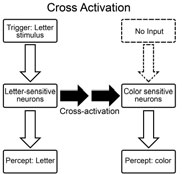
- specifically, visual word form area (VWFA) in the ________ gyrus responds to visual letters, words, and numbers; this is adjacent to V4
▸ hypothesis: in lower synesthetes, there is cross-activation between VWFA and V4
(this could explain grapheme → colour synesthesia)
- areas around the _______ gyrus (specifically, the temporal/parietal/occipital (TPO) junction) implicated in representing more abstract numerical ideas--concepts like ordinality
- anterior inferior temporal (AIT) cortex also found to encode conceptual representations of words, letters, and numbers
▸ hypothesis: in higher synesthetes, there is cross-activation between areas around the angular gyrus and V4 or another higher colour-processing area in the ________ ________ gyrus
(this could explain month → colour synesthesia: each month has an ordinal value)
- the difference between lower and higher synesthesia results from _____ the genes for synesthesia are expressed
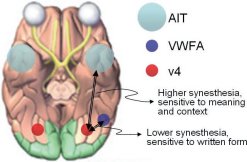
Evidence:
- visual presentation of graphemes (e.g., ____) affects lower, not higher synesthetes
- accounts for the fact that upper/lowercase make no difference, because neither VWFA nor AIT respond differently to capitalization
Hubbard et al. (2006):
- visually identifiable graphemes presented at lower contrast (e.g., light grey on white background) failed to produce synesthetic _______
- VWFA less activated by low-contrast letters, more by high contrast
Rouw & Scholte (2007):
- used diffusion tensor imaging (DTI) to map white matter (tracts of myelinated axons)
• found increased cross-wiring in the right inferior temporal cortex (near VWFA and V4)
• additional anatomical connectivity in left posterior IPS (intraparietal sulcus thought to be involved in _______), and frontal lobes
General problems:
- what about adventitious synesthesia? (no new ___________ are created by hallucinogens, for example)
- why is synesthesia not apparent until mid-childhood? (should be present from birth, because the brain of a neonate is more highly interconnected)
2. Long-Range Disinhibited Feedback
(Peter Grossenbacher & Lovelace, 2001; Richard E. Cytowic & David Eagleman, 2009)
- posit that the degree of neural connectivity is identical in synesthetes and nonsynesthetes
- however, activity is usually ________ by equal excitation and inhibition
- synesthesia is due to (genetically determined) reduced inhibition in existing feedback pathways
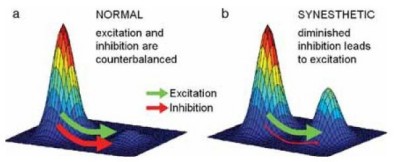
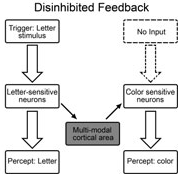
- feedback may come from a ____________ nexus (like the TPO junction)
Evidence:
- accounts for ___-____ effects, because feedback comes from multisensory areas (“more connections” theory also accounts for this)
- acquired synesthesia may be due to brain damage, meditation, hallucinogenic drug use; cannot result from more connections
- LSD blocks receptors for _________ (which is primarily inhibitory); the resulting disinhibition allows neural targets to be more easily activated, hence synesthesia
- the visual cortex can take on a representation of tactile space (e.g., in the newly blind, or even in blindfolded sighted individuals after a few days): evidence for activation of ________ somatosensory-visual connections
General problems:
- adventitious synesthesia and LSD-induced hallucinations are often complex, including visualizations of animals and complex scenes, in contrast to the generic experiences of congenital synesthesia, which generally are simply of colour, for example
- also does not account for synesthesia emerging in mid-childhood
3. Reduced Plasticity:
(Julia Simner, Jamie Ward, et al., 2005)
- if a certain letter is seen in a certain colour, this will strengthen the connection between them
- because we see letters in various colours, this tends to average out
- but if plasticity is reduced, an initial letter-colour pairing may not ______
- accounts for emergence of synesthesia in mid-childhood
Evidence:
Ward & Simner (2003):
- JIW’s spoken word → taste (actually, flavour) synesthesia is likely to have originated during vocabulary acquisition
- ________ that trigger a certain taste also tend to appear in the name of the corresponding foodstuff
e.g. college → “sausage”, Sydney → “kidney”
- there is often a semantic association between triggering word and taste
e.g., blue → “inky”, bar→ “milk chocolate”
- synesthetic tastes are generally childhood foods, rather than foods first eaten in adulthood
- implies that synesthesia is not due to innate connections, but can be influenced by __________ knowledge
Simner et al. (2005):
- tested grapheme → colour synesthetes
- classified responses into 11 common colour terms
- found non-random patterns of colour associations with letters
e.g., 43% linked A → ___, 58% linked B → ____ or _____, 29% linked C → ______, 49% linked O → _____, and 43% linked Y → ______
- also, people who lack synesthesia showed some evidence of the same trends
e.g., 43% chose ___ for A, 47% chose ______ for Y, and 49% chose ____ for B
- high-frequency letters are generally associated with high frequency colours
- the specific grapheme-colour links in synesthesia are not arbitrary--perhaps due to the orderly topographic mapping of many cortical areas
Witthoft & Winawer (2013)
- 11 grapheme → colour synesthetes evaluated
- colour-letter associations closely matched those in Fisher-Price® magnetic letter sets, which were owned by 10 of the synesthetes
- colours matched closely to at least 14 of the 26 letters in the set--a probability of less than 1 in 1 _______ (one synesthete matched to all 26 letters)
- in addition to genetic and perceptual factors, synesthesia must also involve ________ and memory
General problems:
- unclear how this theory accounts for other forms of synesthesia (e.g., day of the week → gender)
- does not account for adventitious synesthesia
• “synesthesia may be the very first perceptual condition for which science can map its ____” (Cytowic, 2009, para. 11)
• synesthesia may not be ______; interaction across the senses is actually the rule rather than the exception (Ward, 2008)
e.g., watching a movie binds vision + audition
- ____________ perception (a unitary experience resulting from combined stimulation of more than one sensory system) occurs in everyone
- in a food, for example, sensory attributes tend to reliably co-occur
e.g., flavour is comprised of taste, smell, touch, temperature, sight, sound, and sometimes even pain/irritation
e.g., a strawberry smells like strawberries, tastes sweet, feels soft, etc.
- why do some odourants smell “sweet”?
- is flavour the result of olfaction and gustation failing to develop as fully segregated, independent senses?
- in other words, is flavour a universal type of synesthesia found in ________?
- this goes against the notion of strict modularity in the brain (Doctrine of Specific Nerve Energies)
• synesthesia may help us understand the binding problem: how are separate aspects of a single stimulus (e.g., colour, form, motion, etc.) reintegrated into a coherent, holistic percept?
- synesthetic experiences are not __________ but are synchronized and separate
- binding of qualia may be accomplished by coordinating subsystems using feedback connections, which requires interconnections between differently specialized areas, resulting in a holistic percept
- a “____________” model suggests that synesthesia arises through an overactivation of parietal binding mechanisms
- applying TMS to parietal binding regions disrupts synesthesia (Esterman et al., 2006)
(hyperbinding may use one of the above neural models--cross-activation or disinhibited feedback--to create simultaneously active areas which are anomalously bound together)
• synesthesia may reveal the ____________ basis of metaphor, creativity, and language (Ramachandran, 2004)
- metaphor:
▸ can be defined as “seeing the similar in the dissimilar”
▸ metaphor is an important potential component of creativity
▸ perhaps this makes the synesthesia gene adaptive (synesthesia is more common in artists)
• damage to the left angular gyrus (implicated in higher synesthesia) leaves patients with an impaired understanding of the dual nature of _________ (e.g., “all that glitters is not gold” is treated literally)
- creativity:
▸ “______” synesthesia allows novel connections to be made
▸ emphasizes the subjective nature of individual experience
- language:
▸ in both English and Tamil speakers, 98% named a rounded shape “_____” and a jagged one “____”; also shown by children as young as 2½ (Ramachandran & Hubbard, 2001b; Köhler, 1929)
▸ this effect is not obtained in patients with damage to the left angular gyrus
▸ implies that objects are not named arbitrarily, but are due to synesthesia-like mapping (called “_____ _________” in linguistics)
▸ thus, a type of synesthesia that we all share may be part of the basis for language